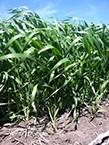North Dakota barley farmer Mark Seastrand said his barley fields are off to a great start. “Conditions were ideal at planting time in mid-May, and timely rain has helped to kick off the growing season,� he said. “We’re cautiously optimistic about this year’s crop.�
Seastrand has a new addition to his farm this year – a newly released variety of barley, Genesis, developed by North Dakota State University. This variety will be harvested for seed. While it is cared for the same as other varieties he is growing, there are differences at planting and through the growth stages.
“For seed production, Genesis is thinly planted,� Seastrand said. “Throughout the growth stage, plants are identical to other types of barley, but the heads will be different at harvest because the kernel is larger.�
Researchers are hopeful its low grain protein may be beneficial when growing malting barley in environments where moisture stress develops after heading.
Seastrand said barley production in his state looks good – especially in the western and central regions where plants are reaching the fourth- and fifth-leaf stage. However, weather has hampered the growing season in areas of eastern and northern North Dakota where late frost and excessive rainfall could potentially affect yield in some fields.
“Overall, the barley crop is ahead of schedule this year,� said Steve Edwardson, executive administrator for the North Dakota Barley Council. “Barley jointed is at 95 percent for the end of June, which has surpassed the 67 percent average for this time of the year. At this stage of development, the nodes on the main stem of the barley plant are first detected and the developing head is just above the joint, or node. This is an early indicator of reproductive stage.�
U.S. Department of Agriculture’s (USDA) National Agricultural Statistics Service (NASS) announced in its end of June crop progress report that barley conditions in North Dakota rated 73 percent good and 13 percent excellent.
The national report, showing combined results from the top barley producing states of Idaho, Minnesota, Montana, North Dakota and South Dakota, also indicates a positive start to barley production this year. Most of the crop is listed in good or excellent condition for this region, which is better than estimates at this time in the previous year, according to USDA reports.
In these early stages of growth, farmers apply herbicides and fungicides as needed to their crops. These applications prevent the spread of disease and weeds within the crop and positively impact quality and yield at harvest.
Precision agriculture tools are employed during this stage of the growing season as well. Auto steer on Seastrand’s tractor and a rate controller on his sprayer, along with a drift control agent for windy days, ensures proper application of fungicides and herbicides. These tools plus the manual inspections Seastrand makes of his fields allow him to monitor the condition of his crop and address any needs.
Timely rainfall is key to a successful crop this year, and it looks like the crop is on the right track in the top barley producing states.
“Although things can change quickly, the crop looks exceptional at this point, and there’s more moisture predicted in the future,� Seastrand said.
USDA crop progress reports are available at http://usda.mannlib.cornell.edu/MannUsda/viewDocumentInfo.do?documentID=1048.
For crop progress reports by state, visit www.nass.usda.gov/Publications/State_Crop_Progress_and_Condition/.
Charts and maps are available at www.nass.usda.gov/Charts_and_Maps/Crop_Progress_&_Condition/2015/.


